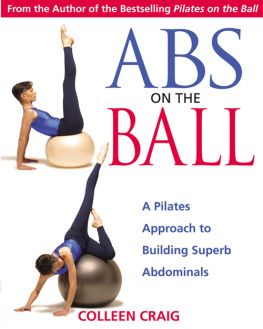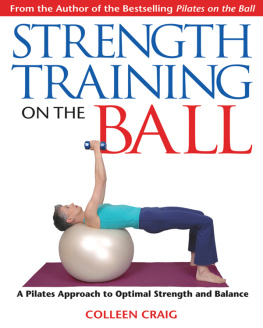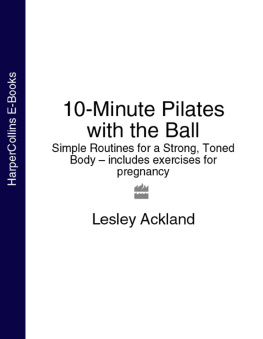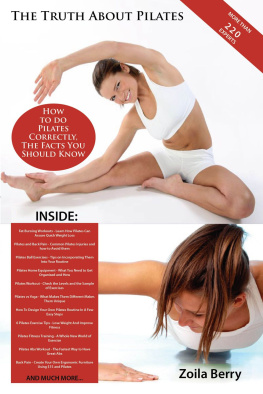Abs
on the
Ball
A Pilates Approach
to Building
Superb Abdominals
Colleen Craig

Acknowledgments
I have had the pleasure and great luck to work with outstanding teachers in my ongoing Pilates training. I would like to sincerely thank Moira Stott-Merrithew for exposing me to and certifying me in Stott Pilates. When I left Moiras extensive certification program and found myself teaching on my own I began to fully appreciate the intelligence of her contemporary approach. I have also learned much from other wonderful teachers and colleagues: Beth Evans, Mariane Braaf, Syl Klotz, Elaine Biagi-Turner, Connie Di Salvo, Mari Naumovski, and Danielle Belec. In addition there are those whose workshops, videos, books, or discussions I have found invaluable: Tanya Crowell, Frank Bach, Karen Carlson, Diane Woodruff, Cheryl Soleway, Paul Chek, Trish Scott, Caroline C. Creager, Leslee Bender, Miyuki Yamaguchi, Janet Davis, Janet Lemon, Esther Myers, Anne-Marie Hood, Laura Misek, Amah Heubi, Petra Dobesova, Katja Hambrecht, Irene Gerstner-Mhleck, Enrico Ceron, and Paola del Fabbro. The concepts behind Abs on the Ball were influenced by the teachings of Joseph Pilates and the research and wisdom of Rick Jemmett, Joanne Posner-Mayer, Stuart McGill, Carolyn Richardson, Gwendolen Jull, Paul Hodges, Julie Hides, and Beate Carrire.
I am very grateful to my sponsors and distributors who supplied the balls and for generously funding the photographs that appear in the book; in Canada, Donna Micallef and Constance Rennett and their hard-working staff at Know Your Body Best; in the States, Dayna Gutru and her associates at Ball Dynamics International. Many thanks to Daniella Smoller of Thera Med in South Africa, Trish Scott of IncrediBall Enterprises in Vancouver, and Nevio Cosani and Ledraplastic factory in Italy for inviting me to present my work.
I am grateful to Susan Lee of Canadian Personal Trainers Network and Mari Naumovski of BodySpheres who read and commented on earlier drafts of the manuscript. Many thanks to Claire Letemendia whose expert editorial assistance greatly helped shape and refine the manuscript. I am grateful to Marie Jover-Stapinski and Simon Fortin for appearing in the book with me. Thanks to David Hou for his wonderful photos and instructive illustrations and to Liz Robertson for makeup. Thanks to Paul Robinson at the University of Toronto Varsity Shop for generously supplying the clothing for both books and the video.
I would like to take this opportunity to thank Susan Davidson, my editor, and her collegues at Healing Arts Press, who so successfully launched Pilates on the Ball into the world. Susan especially made the publishing process for both books extremely gratifying. Her calm approach and expert guidance transformed two messy manuscripts into real and beautiful books. Thanks to Peri Champine for creating the sensational covers, Jon Graham for believing (with Susan) in Pilates on the Ball, Jeanie Levitan, Rob Meadows, and the rest of the design, production, and marketing teams at Healing Arts Press. I would also like to extend my thanks to Tara Persaud and Alan Zweig at Ten Speed Press; my agent, David Johnston; my accountant, John Chaplin; and Tony Yue at Creative Post. A special thanks to Marie Lussier for generously supplying me with legal services.
I am most grateful for the steady, loving support of my family and friends. Dominque Cardona and Laurie Colbert for volunteering to film my video; Lynne Viola (and Monty) for steadfast emotional support over the years; my parents, Lorraine and David Craig; sister, Jane Welch; and nieces, Lyndsey and Lauren. Finally, I am blessed with very loyal students and send them many, many thanks.
Why Another Book on Abdominal Conditioning?
We all understand why some instruction is necessary when we are learning to drive a car for the first time, or operate a computer, or speak a new language. The same applies to abdominal conditioning, even though we use our bodies every day with no instruction manual. If we want to tone our abdominals effectively and receive the benefits of a sturdy low back and optimal posture, we have to teach our deep muscles to work properly. Abs on the Ball is about training the endurance capacity of the stabilizing muscles of the abdomen and back from the inside out. This book will give you the information you need, whatever your level of fitness, to build superb abdominal strength and a healthy back.
Some of the principles introduced here may be new to you. Whether you are a professional athlete, a seasoned fitness buff, or a novice launching into your first workout, it is important to start slowly and carefully with the Fundamental Exercises at the beginning of each practice chapter in order to benefit fully from Abs on the Ball. But before we begin it is worth asking: Why another book on abdominal conditioning? What is wrong with the techniques we learned in the past? And what is so special about working out with a ball?
The Problem with Traditional Ab Conditioning
Every time I visit a gym, attend a fitness class, or watch athletes train I see examples of poor technique, unbalanced bodies, and faulty movement patterns, but nowhere is there more misunderstanding than in abdominal training. People perform endless sit-ups and twists of the spine to create perfect six-pack abs or to sculpt a narrow waist without realizing that they may be wasting time and energynever mind that they may also be damaging their low backs.
The link between low-back pain and weak abdominals is finally becoming recognized, and most people who work out now devote at least some of their exercise time to abdominal conditioning. Some even keep records of the number of sit-ups they do on mats or with machines. Why then are so many disappointed with the results? Why is low-back pain or discomfort so common after workouts?
Imagine the spine as a multisegmented flagpole. The long, superficial muscles of the trunk are similar to the guy wires that balance the flagpole. These large muscles, closest to the outside of the body, span greater distances than the deep muscles and allow for larger range-of-motion actions such as arching the back or bending the spine. The small spinal muscles, more internal to the body, support the links between each segment of the pole. These stabilizing muscles, also called core muscles, are the deep muscles of the abdomen and low back that provide stability for the spine. If these deep muscles do not perform effectively the flagpole will become unstable. And most important of all, if these deep muscles do not have the endurance capacity to do their job of supporting the spine, other muscles may be recruited to fill in, performing in ways for which they are not designed.
Old-style methods for abdominal conditioning tend to drill the body in one fixed direction or pattern. But such movements are not very functional: in daily motion our bodies curl forward, extend out, rotate, and bend sideways; our limbs swivel inward and outward, across the midline of the body and away. Traditional exercises strengthen mainly the outer layer of the bodythe rectus abdominis, for example, a superficial abdominal muscle that runs vertically down the abdomen. The role of the rectus is to flex the trunk, but this muscle does not directly support the spine in sitting or standingnor does it directly assist in healing or preventing low-back pain.
Another point of confusion in traditional abs conditioning involves the hip-flexor muscle known as the psoas, a long, strong muscle that originates on the bony parts of the vertebrae of the lower spine, crosses the front of the pelvis, and attaches at the top of the thighbone. This very deep muscle is not usually considered a stabilizing muscle because its role is to connect core to leg, not core to core. It is very strong, however, and can rush to the aid of the abdominals in traditional conditioning exercises. Consider the abs machine that supports your body weight on your forearms and allows your legs to hang freely. As you lift your knees to perform the exercise, the burn you feel is in the hip flexors (including the quadriceps) and in the superficial rectus abdominis muscle, not in the deep abdominals.
Next page







